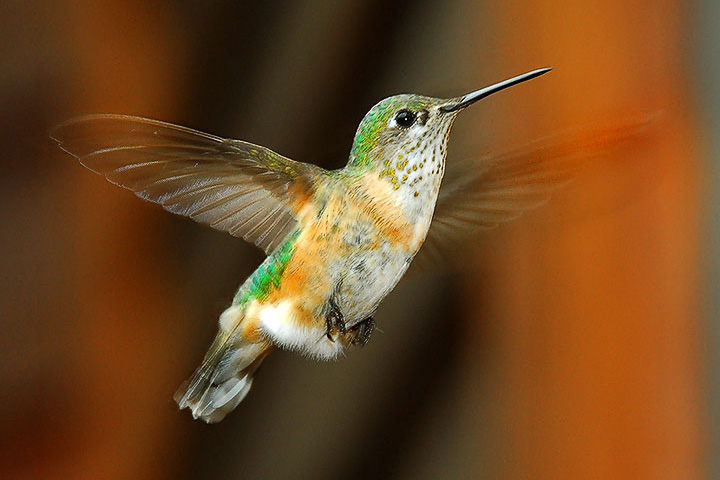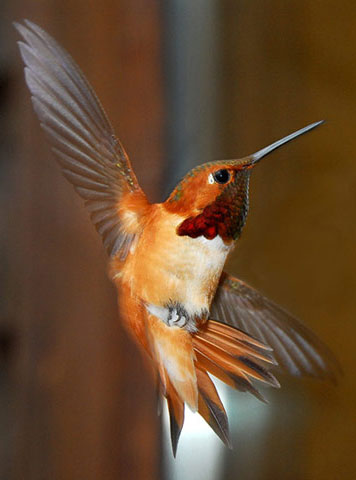Hovering
Hovering is hard work. If a bird is moving through the air, it only takes a gently tilted wing to provide lift—a case in point is gliding. But, when a bird is hovering, it is not moving through the air, so how does a hovering bird manage to stay airborne?
The best hoverer is the hummingbird. Instead of holding its body horizontal and flapping its wings up and down, the hummingbird tips its body back and transforms the downstroke into a forward stroke and the upstroke into a backstroke. During the forward stroke, the wing is tipped up so that it pushes air down; during the backstroke, the (hand) wing is turned over so that the tipping is reversed and once again air is forced down. Amazingly, a hummingbird executes this manoeuvre anywhere from 20 to 80 times a second depending upon the species. The tiny Rufous Hummingbird, commonly found around Kootenay Lake in the summer, executes the manoeuvre 70 times a second.
Certainly some other small birds can hover, but doing so is so energetically expensive that they only do it for very short periods, and usually only when landing. The hummingbird is the only bird capable of hovering for many minutes at a time.
Windhovering is often practiced by birds which are too large to hover. When a bird hovers, it is flying, but not moving through the air; when a bird windhovers, it is flying through the air, but it is flying upwind at the same speed as the wind. The result is that a windhovering bird remains stationary with respect to the ground. Many large birds use windhovering for hunting and fishing because it enables them to watch a fixed location on the surface and so easily spot the movements of their prey. However, the tactic only works when there is a brisk wind comparable to the crusing speed of the bird. Strictly, windhovering is not hovering, but it is an interesting tactic used by some birds to temporarily hang over one spot.
 This tiny female Calliope Hummingbird is hovering. Its body is tipped back and its wings are executing a forward stroke (which would be a downstroke if the bird’s body were horizontal).
This tiny female Calliope Hummingbird is hovering. Its body is tipped back and its wings are executing a forward stroke (which would be a downstroke if the bird’s body were horizontal).
 This male Rufous Hummingbird is actually flying backwards. It has tipped its body and wings sufficiently that it exerts a reverse thrust.
This male Rufous Hummingbird is actually flying backwards. It has tipped its body and wings sufficiently that it exerts a reverse thrust.
 A Bald Eagle is windhovering: it is flying upwind at the speed of the wind. This enables it to hang over one spot on the suface. It is using this technique to try to catch the female merganser which is hurriedly passing below. The merganser escaped.
A Bald Eagle is windhovering: it is flying upwind at the speed of the wind. This enables it to hang over one spot on the suface. It is using this technique to try to catch the female merganser which is hurriedly passing below. The merganser escaped.
![]()